An Interview with Ken and Roberta Williams – Colossal Cave, Sierra and more
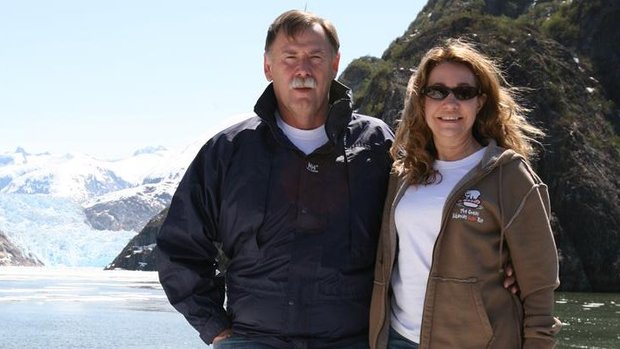
- 3 Comments
Rarely has an interview introduction been so unnecessary than for Ken and Roberta Williams, who together founded On-Line Systems in 1979 (later becoming Sierra On-Line) and pioneered the graphic adventure genre as we know it today, along with many other advances in design and technology over the years. As adventure fans we owe so many of our fondest gaming memories to them, but when they sold the company and walked away – or in their case, sailed away as it turned out – from the industry they'd done so much to help build in the late 90s, it seemed that would be the final chapter in their legendary gaming careers. However, life has more than a few surprises in store, and Ken and Roberta shocked the world when they announced that they were not only making their first new game in 25 years, but that it would be a "reimagining" of the game that started it all, Colossal Cave (aka ADVENT or Adventure, from which the genre got its name). To learn more about the exciting project that lured this iconic husband-and-wife team back after so many years away, I chatted with them at length about the new game, along with doing some reminiscing about the glory days of Sierra and their incredible "retirement" that spawned a whole new kind of real-world adventure.
Hi, Ken and Roberta! Glad to chat with you both again. Since you haven’t made any games in decades now, maybe start by introducing yourselves and telling us who you are… Ha! Kidding, of course. Any adventure gamer that isn’t intimately familiar with your legendary careers at Sierra goes straight to the back of the class. But you have been away for a while! We’re thrilled you’ve returned, but I guess the first question is: why now? And the natural follow-up is: why Colossal Cave?
Roberta: A combination of reasons: The lockdowns (stuck at home), Ken needing a project, the idea was raised of bringing the wonderful game of Colossal Cave to modern gamers…why let it die on the vine? This could be fun to do…
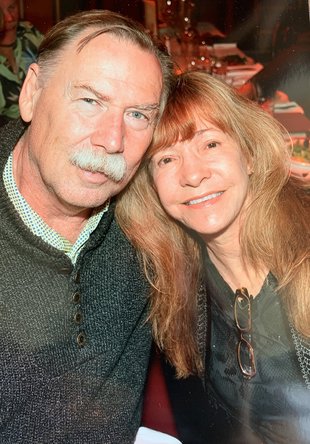
Ken: Roberta and I were very sad about how Sierra ended. After the company was sold we decided to forget video games and just focus on cruising the world on a small boat. We stayed 100% away from anything related to games. Then when COVID locked us down, we had to stop traveling. I was bored and wrote my book about Sierra. The positive reaction to the book made me curious about the modern world of games. I decided I'd learn to program a game, mostly just to fill time. After watching virtually every Unity training video on the internet, I decided to write some small simple game, but I couldn't decide what to program.
Roberta suggested doing Colossal Cave and I thought, "That would be easy. It's just a simple text game." I found an artist (Marcus Mera) who would work with me for a piece of the action, and started to work. Roberta saw what Marcus and I were working on and said, "That's terrible. You can't market that." I didn't think it was so bad, but she said, "Let's put together a team and do it right."
Millions of dollars and two years later – we have a game!
The original game clearly meant a lot to you personally, but what is it about Colossal Cave that convinced you a reimagining would appeal to today’s modern gamer?
Roberta: Since I originally played it (yes, a long time ago!) – which did start my career and the existence of Sierra On-Line (as it came to be) – I have always had high regards for the game and thought it a great design. A great design is a great design! It’s like a script to a movie or a book. If it’s great then, why not later. Like a script, a game design is the blueprint for a game – and it seemed to me that the text ‘blueprint’ of Colossal Cave could be brought back (in its original form as the script requires), but with the added beautiful 3D graphics, character designs and animations, music, sound effects, special effects, etc. – to appeal to today’s gamers.
Ken: There are things about Colossal Cave that I think make it super special. It is an adventure game, but very different from the adventure games Sierra produced, or anything out there now. It has a point system, replayability, action. It is a wide open game. There are some puzzles that block you from progress in a couple places, but not many. For most of it the entire world is wide open to the player. You can play it for the exploration, or as an adventure game, or to score points, or all of the above. It has some interesting things that were way ahead of its time. For example, the game is watching the player and adjusting how the game plays based on player actions. There are no dialog trees or anything to slow the player down. I always had rules about never taking away control from the player. This game rocks. You never are stuck listening to characters drone on about stuff that bogs down game play. It’s an amazing game!
Let’s talk more about that word “reimagined.” Other than the obvious addition of graphics, in what ways is the new Colossal Cave similar to the old one, and in what ways is it different?
Roberta: The gameplay is exactly the same (or as ‘exact’ as I could get it, keeping in mind issues in regards to 3D and VR graphics). But the main difference would be in designing the look and feel of the cave – keeping in mind the text descriptions of the original game, but adding my own ‘touches’ of fantasy, atmosphere, and subtleties of story. Having said that, I feel that I have been careful not to add too much of my own ‘touches.’
Ken: If you’ve ever read a book that was remade as a movie, you know what we did. For example, The Lord of the Rings. The book and the movie are the same thing – kind of. But, wow! What a difference! We bring the text to life. The characters are there, the plot is there – but, it’s a universe you can live in, instead of reading or just watching.
For those who never played the original, or any of its text-based remakes, what exactly is Colossal Cave all about?
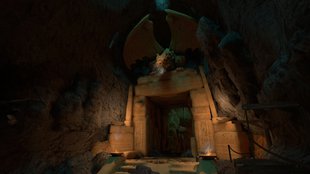
Roberta: It’s a massive exploration of an actual cave system (Mammoth Caves of Kentucky) made into a fantasy cave – with roaming characters there to present exploring obstacles (some injurious!). The overarching objective, besides the fun of exploration, is to find and return treasures (many of them) to a small building (seen at the beginning of the game). Also, this adventure game is points-based and so you’re also looking to add to your score, and perhaps to win the perfect score of 350 points. There are many strategies for playing this game that will become more apparent as you play it. It is definitely required to play multiple times to acquaint yourself with the cave, its ‘rules,’ and learn the different paths you can take, and how to get past the many ‘obstacles’ and where the treasures are located, and the difficulty in obtaining them. Besides, there are a couple of mazes to figure out…and, really – the cave itself is essentially a labyrinth! The final step in playing this game perfectly is to figure out HOW to get the perfect score of 350 points. Some people will decide that they just love going through the cave and discovering it and seeing all that is contained within, others will decide that getting the high score of 350 points will be their ultimate objective. The game is VERY open to many ways of playing it!
Ken: While exploring the cave, the secrets of the cave are slowly revealed. I don’t want to give them away. But, consider yourself more of an archaeologist exploring a new world deep within the cave. You’ll learn what is going on as you play. It’s not what you think.
There are also rumors that strange creatures inhabit the cave, and that magic works. We don’t give the players much of a hint and leave them to discover the secrets of the cave. The first rule of Fight Club is…
“Maze” has become something of a dirty word for many gamers. Does your Colossal Cave make any concessions for those who have a poor sense of direction and get lost easily? (Not me, of course. Purely hypothetical question!)
Roberta: Well, the mazes do exist in the original game and, in keeping with the idea of maintaining the original gameplay, the mazes still are there – and, may I say – might it be good for today’s gamers to perhaps learn the patience of figuring out a maze? There’s a certain pride that you feel once you’ve figured it out! And, if they do get flustered with a maze, we do have a hint that is available to help out…after they’ve struggled for a bit. (Will cost you some points though, if you take it😏)
Ken: The mazes are there, and they can be mapped on paper, which purists will want to do. Or, we included an auto-mapping feature which can be used. Or, the best of all is to solve the maze as if it were a puzzle. Recently we had one reviewer who was ready to throw his computer through the wall rather than try to solve the Maze All Different. In fact, there are three different approaches to that maze and if you think of it as an adventure game puzzle, and look for clues, the maze is easy.
And ultimately, you can always google a hint. But what fun would that be?
Did you imagine when you started that the project would become … well, so colossal?
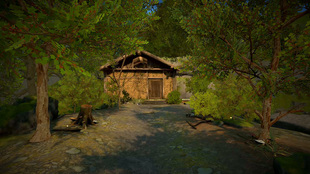
Roberta: Actually, easy answer: no. I had forgotten how intricate and huge the game is – it had been a long time since I had played it! Getting back into it, and studying the original game source – the original Fortran game code – I began to realize what a big, complex game it really is – and then to start thinking of the amount of 3D graphics involved, character animation, etc., etc., not to mention the immense amount of programming to be done, and then to port it over to the many game platforms available today…and in something like 15 languages! Whew – huge!
Ken: If I had known then what I know now… I’d be retired now! Building a game is incredible fun, but it’s also WAY more work than I imagined. Luckily, we assembled a great team who made things easy on me, but it was still a long haul. The biggest issue was that the game was much larger than we realized. It’s a deceptively simple game, even as a player. But, once you reach the end of the game you realize that you’ve only scratched the surface.
Most movies based on a book “cheap out.” They’ll take a 500-page book and condense it to a 90-minute movie. We didn’t want to do that. We knew it all had to be there. We went all the way and did it right.
Technology has advanced so much since your time at Sierra. What challenges did that present in returning to the industry after so long away?
Roberta: Not as much as you’d think. You know the whole cliche of ‘You never forget how to swim or to ride a bike?’ Well, that has proven true for Ken and I. We just kind of dived into it as if we had been developing games all along! Sure, we had to learn ‘new’ things, of course. Had to come up to speed on new terminology/programming – and understand today’s game playing in its various forms, for instance interfacing with the game (game mechanics), and how it differs now versus 25 years ago. One of the biggest hurdles to face was to figure out how to play and ‘communicate’ with this game given that the original is a ‘text’ adventure game, and you played it via a parser (typing in one or two word commands via your keyboard). Our game does not have a parser because – unlike with the mazes which we did keep intact, I decided that today’s player would not be comfortable playing a game utilizing a parser. So we went to the old standby: point and click. And that is working well for this game.
Ken: We were incredibly lucky. There are still a lot of Sierra fans out there. Many of them are now in senior positions at the console companies or in the industry and help came at us from every direction. This is a project that not only we cared about, but also a lot of people who were in positions to help us. The teams at Nintendo, Sony, Unity, Meta, Microsoft, all wanted to see the project do well. Even in our recruiting, we were able to get people that might not have worked for a startup on their first product, simply because of the Sierra heritage and the history of this game. I cannot overstate how special this game is to a lot of people.
You’ve also had to deal with working remotely from your team, which presents a whole other set of challenges all its own. What’s that experience been like?
Roberta: It’s allowed us to stay at home and work – which I like! And it’s also allowed us to find and work with very talented people from around the country, and around the world! We met often with them via Teams, or Zoom, or whatever was necessary…and it worked very well. It’s amazing! And everyone stepped up to the challenge of working on this game – it’s been a wonderful team. Ken and I have been incredibly lucky to work with them!
Ken: If I were running Sierra today, the decision to let people work at home would be a tough one. There are both pros and cons, and they aren’t always what you’d think.
On the positive side, it is amazing being able to share screens with anyone at any time, and be able to debug as if we were sitting side by side. Also, I was able to contract people based on where they live, and select the best people available from anywhere in the world. Geography was a non-issue. Contrast that to Sierra where I constantly had to relocate families to live by our office, or limit my hiring to a 10-mile radius. I actually felt closer to the team on this project, thanks to Microsoft Teams, than I ever did at Sierra.
On the negative side, not everyone is self-motivated. Some people are lazy and don’t work when you can’t walk past their desks. Some people have kids at home, or lots of distractions. The beauty of an office is that you have a lot more control of the working environment.
Overall, the remote working worked for us on this project. But, were I running a company like Sierra today, it would be a tough decision. I think I’d have people come to the office. Not sure.
One of the big technological leaps forward in recent years is virtual reality, and you’ve put a significant amount of focus into making Colossal Cave an immersive VR experience. How did you pull off that feat, given that you had no prior experience with it as game makers?
Roberta: For me, that’s not ‘entirely’ true. My last two games, King’s Quest VIII: Mask of Eternity, and Phantasmagoria, were 3D rendered game worlds, but because computers and video game machines were not powerful enough back then to navigate through a game in 3D as is possible now, we weren’t able to utilize those worlds in the same way as with this new game, Colossal Cave. So, back then, rather than having the game world ‘move along’ with you as you navigate through it, we utilized our 3D worlds by switching camera angles as the avatar moved through it.
So, it wasn’t really that big of an ‘issue’ for me to immediately think in 3D or VR.
Ken: It was a struggle and probably doubled the cost of the project, at least. VR is not easy. We figured it out and even believe we pioneered some things. And, from a design perspective, there are things Roberta did which are very different from other VR apps. One of our philosophies at Sierra was to do things “our way” and ignore what others do. It gave Sierra that special feeling that many people remember. You’ll see that our VR game feels very Sierra-ish, and that’s intentional. We wanted to do something that was unique to us and that we thought players would enjoy.
Do you have a personal preference for playing on a standard monitor or in VR?
Roberta: For me: Standard monitor. Although, I have to say that our Colossal Cave is AMAZING in VR!
Ken: For me: Standard monitor. That said, the VR experience must be experienced at least once. To be honest, a lot has to do with how people react to VR. I get nauseous fairly easily in VR. It isn’t just our game. I played an hour of mini-golf and had to lie down. Some people are fine in VR and some aren’t. I’m on the “aren’t” team.
Have you been able to get out on the water at all during production, or have you had to set aside your seafaring ways to work exclusively on the game?

Roberta: Not really. This last summer, Ken and I were essentially living on our boat up in the Pacific Northwest, intending to get out and cruise around, but given the issues of working on this game, we mostly stayed on the boat in a ‘really nice’ marina – and worked. But oh, well…it was worth it!
Ken: Elon Musk’s Starlink is a miracle for boaters. Looking forward, we should be able to cruise and have high-speed internet. There is a special version of Starlink for boaters which we’ll have this summer. Last summer we had the home version and that didn’t really work for us on a boat. But looking forward we think we’ll be happily able to cruise and surf at the same time.
I know most gaming fans probably want to hear about Sierra, but I’m every bit as interested in your storied post-Sierra careers. How did you both get so involved in boating?
Roberta: After we sold Sierra we needed something to do. We were still really young and definitely nowhere near the idea of a rocking chair! And, we like adventure and challenges! The idea of cruising around the world – which we did for 15 years or so – fit the bill for us! And it was an incredible experience and the time of our lives. Don’t regret it for a minute!!
Ken: Roberta and I are compulsive people. If we had decided to go into knitting after Sierra, we’d probably have knitted one of the biggest sweaters ever knitted. We don’t tend to do things half-way. Our boating took us off the grid and around the world. I got licensed as a captain in the US and Europe. And, out in the middle of the ocean on a tiny boat, if something breaks and you can’t swim 1,000 miles, you are kind of up the creek. So I had to get trained in diesel engine repair, fuel systems, electrical systems, etc. For instance, I am now a licensed marine electrician. We visited 27 countries with our little boat, and crossed the Atlantic and the Bering Sea. We had lots of magazine covers with our boat pictured, and when we were boating we were more recognized for our boating accomplishments than what we’ve done with games.
Boating internationally is like the ultimate adventure game.
We could easily fill up an interview all about your real-life boating adventures, but I’ll limit myself to asking for your favourite experience.
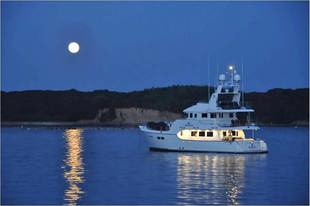
Roberta: I’m torn, so I’ll pick two: 1. Cruising along the Aleutian Islands from Alaska to Petropavlovsk in far-eastern Siberia, then on to Japan and cruising down to the Osaka area before ending that particular cruising season of 2009. 2. Cruising Turkey (seasons 2011 and 2012) – an incredible country with wonderful people and beautiful waters and sightseeing!
Ken: My favourite experience? There is nothing like being anchored in the middle of nowhere, on our boat, sitting in the hot tub, sipping an adult beverage. No civilization. No people. Just quiet and peaceful.
I saved a little space to talk about Sierra, as I’d surely be run out of the adventure gamer’s guild on a rail if I didn’t. But since you’ve already spoken about those days at length, Iet’s just do a quick rapid-fire quiz:
- Fondest Sierra game:
Roberta: Again – two: 1. The King’s Quest series -- I loved the fairy tale and myths/legends aspect of them. 2. Phantasmagoria – definitely a huge departure from King’s Quest…but a lot of fun to write and develop! I was able to experiment with really challenging technology, not to mention the obvious change in direction of my writing and designer skills. This answer though, does not negate any of the other games that I, or many of our prior designers worked on for Sierra…they were all great!
Ken: I work hard, so when it comes time to play I like silliness. I was a Leisure Suit Larry and Space Quest fan. I also spent WAY too many hours playing Dynamix’s pinball and The Incredible Machine.
- Most unpleasant surprise:
Roberta: The treatment I received after we sold Sierra from the people that bought our beloved company. It was one of the saddest and most disappointing (a mild word) times of my life. I continued to work on King’s Quest 8 after the sale of Sierra for almost a year…and it was rough going; I was unprepared for the discourtesy I received. I stuck it out though; I didn’t want to disappoint the many King’s Quest fans.
Ken: We NEVER would have sold Sierra if we’d known we were selling to crooks. The big surprise at Sierra was that we were immediately treated like dirt post-acquisition. Not just Roberta and me but all of Sierra. The company was “cash cowed” and destroyed. Unbelievable.
- Proudest achievement:

Roberta: Besides my family, I will say – in repeat of my prior answer about my fondest games – the same: The King’s Quest series, and Phantasmagoria.
Ken: The Sierra Network! Al Gore gets credit for creating the internet, but if you look back closely you’ll see that Sierra was there pushing the technology and creating the future of online gaming.
The first time The Sierra Network went live, we had approximately 80 senior citizens with computers, linked together to play cards. It was the first ever massively multiplayer game anywhere of any sort. I knew immediately we were changing the world and that it was the beginning of something huge.
- Biggest regret:
Roberta: I don’t know…selling Sierra, I suppose. Although, Ken and I did recover from that, and did enjoy our cruising life. And, working on this game, Colossal Cave, has been a boon…because I was able to kind of get back into the groove of adventure game development and test out the waters again. It’s been very rewarding.
Ken: I do regret selling Sierra, but if we hadn’t sold it, we would never have done the boating, or built the Colossal Cave game, or a million other good things that have happened to us. In general it is best not to dwell on past mistakes, because I can’t imagine how our lives could be better today. I’m sad for the people who worked at Sierra. That does bug me. And, I’m sad for our customers and for all the great games we would have built. But ... overall, I’m happy!
- Best day:
Roberta: My marriage, and the birth of my two children – bar none. (Sorry…it’s the truth).
Ken: I’m thinking of a day in a van that eventually led to a marriage. But, I should probably stick at just saying, “Marrying Roberta!”
And finally, a broader reflection: When you think back on Sierra now, what sticks with you the most?

Roberta: After my marriage and the birth of my two children, Sierra would be the premier event of my life. It defined me in a way that I never knew existed. It showed me the things that I could do or accomplish. I changed dramatically as a person upon the ‘birth’ of Sierra. That’s why, I think, that I was so sad when we lost it, and when I was so rudely rejected by the ‘new’ Sierra people while I was still there trying to work on King’s Quest 8. My world, at that point, was torn asunder, and it took time to recover. But I did!!! And I think that working on Colossal Cave now has also been very invigorating for me.
Ken: I do often try to decide if we were just in the right place at the right time, or if we were actually good at our jobs. I think overall that we did some really dumb things, and would have washed out if the industry hadn’t been so small. We didn’t have a lot of competition. We were young kids doing cool stuff. It wasn’t a hyper competitive environment. But, over time, we got smarter and by the time Sierra was sold, we knew what we were doing. So... it was a combination of being in the right place at the right time, learning on the job, and being willing to improve ourselves and get smarter over time.
Ultimately, I think it was one major thing that made Sierra so great: We really cared about customers. We did a lot of long-term planning and understood that it wasn’t about any one game. We valued the longer customer relationship and really focused on having customers feel a part of the Sierra family. We goofed from time to time and customers stuck with us because they knew it was a rapidly evolving industry and there were no roadmaps. It was just an amazing time.
Thanks for that walk down memory lane. I’m sure many of our readers are nostalgically reminiscing about how Sierra touched their own lives over the years, so we thank you sincerely for that. But that was then and this is now, and right now we’re anxiously looking forward to Colossal Cave! When can we expect the game to arrive?
Roberta: I’ll let Ken go over all that, as he will probably wish to do a bit more explanation than I would… Plus, that’s more in his domain than mine (programming and technology, I mean).
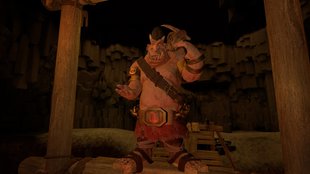
Ken: The game will begin launching on certain platforms very soon. One inside joke at the company is that our goal is to have the game run on a toaster. The hidden meaning in this is that we want the game to run on whatever device players want to play it on. I can count easily 20 different devices we are targeting. On January 19th we’ll release Colossal Cave on Nintendo Switch, PS5, Mac, PC, Quest 2 VR, Steam Deck and Xbox X|S. We’ll follow it not too many weeks later with PS4, Xbox One (approximately mid-February), Pico VR and PC VR (mid-March). Then will come mobile versions. And we’re looking at things like Apple TV and Roku. We are committed to putting this game wherever people want to play it. I’m not sure we’ll ever get it onto toasters though. But knowing us, if it can be done, it will be done.
If anyone is still unsure whether a spruced-up reimagining of a nearly fifty-year-old spelunking adventure is for them (let alone the first new Ken and Roberta Williams game in over two decades!), the floor is yours to seal the deal.
Roberta: I have said, and I believe this to be absolutely true, that not only is Colossal Cave arguably the first adventure game in the world (and maybe even the first ‘real’ computer game in the world), but I think that the game design of this game (designed by Will Crowther and Don Woods) is one of the most elegant game designs that I have ever seen or experienced. And I thought so back then when I played it as a very young woman. And working on it now, I believe that more than ever! It’s timeless – a design, in and of itself, is not necessarily antiquated on ‘when’ it originated (think Shakespearean plays!). A game ‘design’ is like a script or a blueprint for something like – a movie, play, or maybe a building. The design can be very elegant and wonderful – it just needs some updating. That’s what I believe with this game – it’s timeless, it’s elegant, it’s fun, challenging, and very immersive. It will make you think! Time will tell as people play it. And no, I don’t think that it’s for everyone – I would call it an intermediate to advanced adventure game. But for those who love a challenge, puzzles, obstacles, exploration, calculating strategies…I think you’ll love it!
Ken: One of our engineers, Jon West, did Skater XL. He’s an action game kind of guy. From day one he was honest that he would never consider an adventure game. It took him months to be willing to give the game a try. But when he did, he quickly “got it.” He’s an absolute convert, and I’m sure he’ll now consider other adventure games. I hope he will like them as well, although maybe not. Colossal Cave is an odd duck. It created game genres, it isn’t part of a genre. It shouldn’t be pigeonholed, but it should be played. Try it, you'll like it. That’s all I can say.
Is it too early to ask what the future has in store for Ken and Roberta Williams after this?
Roberta: Let’s see how well this game does out there! Too soon to say😏
Ken: No. We’d encourage you to ask it, and even give ideas, because we really have no idea whatsoever. One of the first rules of boating is to say that, “Plans are best written in the sand at low tide.” In other words, it’s good not to lock yourself in. We’ve proven that we can assemble a team and ship a high-quality game, if we want to. The next step is to think about whether or not we want to do another game. Until we’ve put this game behind us, it is silly to think about some future game. We’ll get this out there and then make some plans, and then wait for the tide to roll around and see if the plans hold. Your guess is as good as mine.
So Ken, no response yet from Elon to your musings about possibly running Twitter?
Ken: I was half kidding, but also half serious. I don't think Elon would take me, and I'm not sure I'd want to do it, and if I did want to, Roberta would probably divorce me. I do believe it is the opportunity of a lifetime for someone. I wouldn't be interested for the financial reward. We already have everything we need. There are hundreds of reasons why I think Twitter needs someone with my background, but preferably not me. Whoever runs Twitter really is in a position to change the world. It's going to be a difficult position for someone, but also an amazing opportunity to really make a difference. If this were 20 years ago, and we weren't so happily retired, I'd be banging on Elon's door begging for the job. Remember that Sierra was Sierra ON-LINE, over a decade before anyone had heard of the internet. I am fascinated by the cultural issues and opportunities associated with linking people together.
Thanks very much to both of you for taking the time to do this. As we draw close to launch day, good luck with Colossal Cave!
Roberta: You’re very welcome. Our pleasure.
Ken: Thank you!!!!


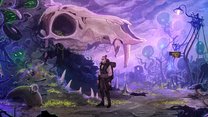
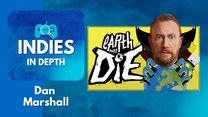
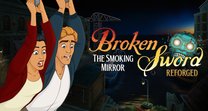
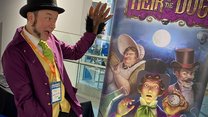


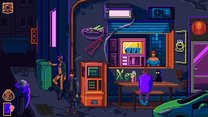
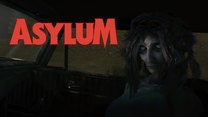
3 Comments
Want to join the discussion? Leave a comment as guest, sign in or register.
I really enjoyed this interview. Thank you!
Reply
This is a great interview, Thanks
Reply
Very interesting interview. Of course Roberta uses emojis lol. Thanks.
Reply
Leave a comment